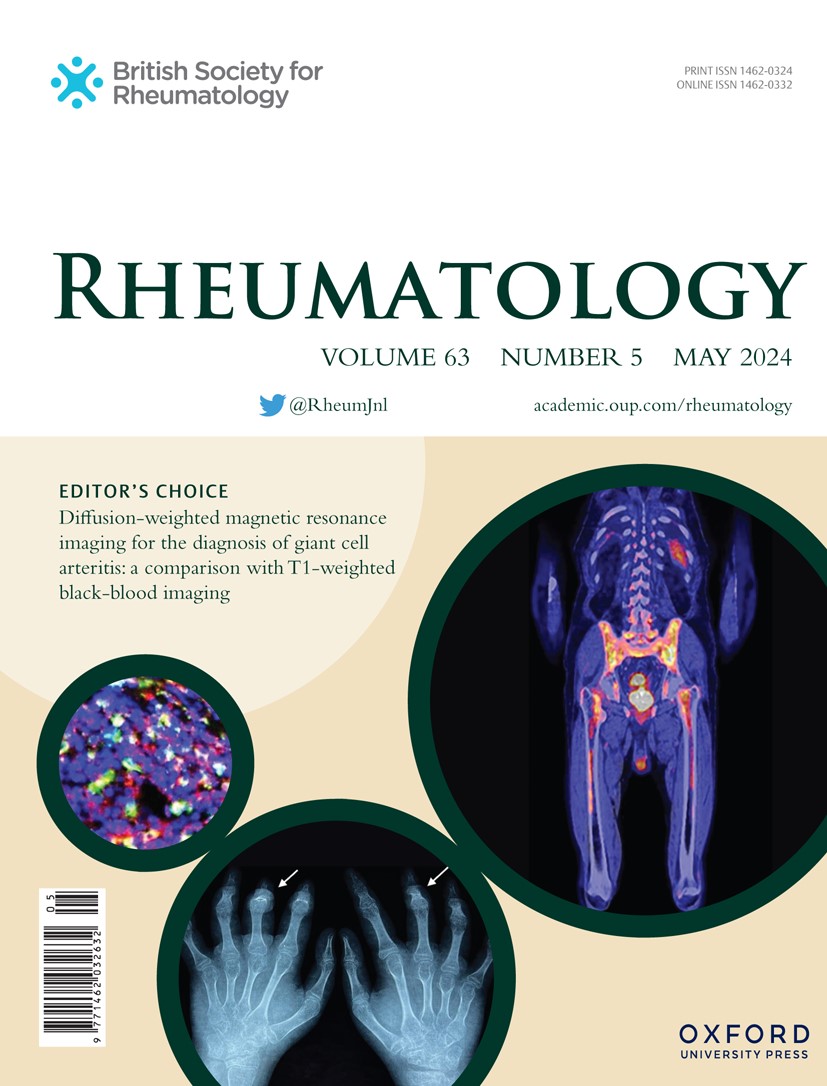髓源性抑制细胞和单核细胞是银屑病临床表型和活动性的生物标志物
IF 4.4
2区 医学
Q1 RHEUMATOLOGY
引用次数: 0
摘要
目的探讨骨髓源性抑制细胞(MDSCs)比例、单核细胞亚群与银屑病(PsD)临床表型和疾病活动性的关系,包括银屑病(PsO)和银屑病关节炎(PsA)。方法对47例PsD患者和10例年龄、性别配对的健康对照进行横断面研究。使用多参数流式细胞术,我们评估了外周血中粒细胞(G)和单核细胞(M) MDSCs,经典,中间和非经典单核细胞。我们根据临床特征、PsD表型和治疗组比较这些细胞群。我们通过多变量logistic和线性回归评估了它们预测银屑病面积和严重程度指数(PASI)和银屑病关节炎(DAPSA)疾病活动性的能力。结果与健康供者相比,PsD患者成熟G-MDSCs减少(5.88%比60.97%),M-MDSCs增加(0.62%比0.02%),精氨酸酶-1和PDL1表达减少(12.2%比4.68%),非经典单核细胞扩增(12.2%比4.68%)。在有皮肤特征的患者中,成熟G-MDSCs增加,精氨酸酶1表达降低。G-MDSCs与皮肤疾病活动性相关(PASI (β 5.05, p= 0.05)),而非经典单核细胞与活性PsA相关(DAPSA (β 0.68, p= 0.004)),突出了它们作为疾病活动性生物标志物的潜力。结论:在PsD中,G-MDSCs与皮肤疾病活动相关,而非经典单核细胞与肌肉骨骼特征相关,突出了它们作为PsD疾病活动的潜在生物标志物的作用。针对这些细胞亚型功能的进一步前瞻性研究将证实它们与PsD活性状态的关系。本文章由计算机程序翻译,如有差异,请以英文原文为准。
Myeloid-derived suppressor cells and monocytes are biomarkers of the clinical phenotype and activity of psoriatic disease
Objectives To assess the relation between the proportion of myeloid-derived suppressor cells (MDSCs), monocyte subsets, and the clinical phenotypes and disease activity of psoriatic disease (PsD), including psoriasis (PsO) and psoriatic arthritis (PsA). Methods We carried out a cross-sectional study including 47 patients with PsD and 10 age and sex-paired healthy controls. Using multiparametric flow cytometry, we evaluated the granulocytic (G) and monocytic (M) MDSCs, classical, intermediate and non-classical monocytes in peripheral blood. We compared these cell populations according to the clinical features, phenotype of PsD, and treatment groups. We evaluated their capability to predict disease activity measured by Psoriasis Area and Severity Index (PASI) and Disease Activity in Psoriatic Arthritis (DAPSA) by multivariate logistic and linear regressions. Results In comparison to healthy donors, PsD patients displayed lower mature G-MDSCs (5.88% vs 60.97%), increased M-MDSCs (0.62% vs 0.02%), decreased expression of arginase-1 and PDL1, and expansion of non-classical monocytes (12.2% vs 4.68%). Increased mature G-MDSCs and decreased arginase-1 expression were seen in patients with cutaneous features. G-MDSCs were associated with cutaneous disease activity (PASI (β 5.05, p= 0.05)), whilst non-classical monocytes were related to active PsA (DAPSA (β 0.68, p= 0.004)), highlighting their potential as disease activity biomarkers. Conclusion In PsD, G-MDSCs relate to cutaneous disease activity, whereas non-classical monocytes correlate with musculoskeletal features, highlighting their role as potential biomarkers of disease activity in PsD. Further prospective studies addressing the function of these cell subtypes would confirm their relationship with PsD activity status.
求助全文
通过发布文献求助,成功后即可免费获取论文全文。
去求助
来源期刊

Rheumatology
医学-风湿病学
CiteScore
9.40
自引率
7.30%
发文量
1091
审稿时长
2 months
期刊介绍:
Rheumatology strives to support research and discovery by publishing the highest quality original scientific papers with a focus on basic, clinical and translational research. The journal’s subject areas cover a wide range of paediatric and adult rheumatological conditions from an international perspective. It is an official journal of the British Society for Rheumatology, published by Oxford University Press.
Rheumatology publishes original articles, reviews, editorials, guidelines, concise reports, meta-analyses, original case reports, clinical vignettes, letters and matters arising from published material. The journal takes pride in serving the global rheumatology community, with a focus on high societal impact in the form of podcasts, videos and extended social media presence, and utilizing metrics such as Altmetric. Keep up to date by following the journal on Twitter @RheumJnl.
 求助内容:
求助内容: 应助结果提醒方式:
应助结果提醒方式:


